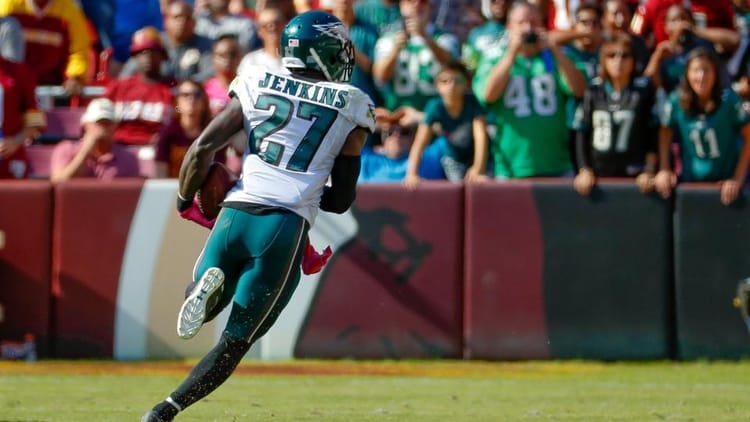Eagles’ Malcolm Jenkins Can Do it All

Minnesota Vikings safety Harrison Smith is suddenly in the spotlight after soaring into the pages of Sports Illustrated. To many in Minnesota, he’s been a star from the moment he set foot on the field, and this recognition is long overdue.
Forget Earl Thomas, Eric Berry, and Eric Weddle; Smith has quietly been the NFL’s best safety since Mike Zimmer arrived as head coach in 2014. In that same time, the Philadephia Eagles have enjoyed comparably elite play from their own safety, Malcolm Jenkins.
Jenkins joined the Eagles in 2014 and played well enough the following season to earn a four-year, $35-million contract extension. In 2015, he was Pro Football Focus’s second-ranked safety and netted one of the that year’s more impressive stat lines — 106 tackles and two interceptions, including a 99-yard return touchdown against the New England Patriots.
Much like Smith for the Vikings, Jenkins is a do-it-all player for the Eagles; he’ll line up deep, creep into the box, and even cover tight ends or wide receivers in one-on-one situations. To Sam Bradford, he’s a familiar, looming presence; to the Vikings, he’s a player the offense must account for on Sunday.
The Vikings are used to Harrison Smith affecting the outcome of games. Whether it’s a crucial tackle for loss or deflected pass, he always finds a way to positively impact Mike Zimmer’s defense. Through five games this season, the Vikings have yet to meet their match, but Jenkins poses a formidable threat.
Although he’s only the 18th-best safety per Pro Football Focus’s rankings this season, Jenkins scores positively in coverage and against the run. And while he’s not the blitzer that Smith is, Jenkins is more than capable of lining up and playing in the box as a force defender.
He was effective against the Washington Redskins last week, finishing the day with six tackles, two passes defended, and an interception. The interception, which Jenkins returned for an early touchdown, was the highlight of an afternoon that also saw the eight-year veteran struggle in coverage.
As Zach Berman wrote, it was the “plays that weren’t on the stat sheet” that will vex Jenkins as prepares to face the Vikings and his former teammate, Bradford. Redskins quarterback Kirk Cousins found Jamison Crowder for a 16-yard touchdown with Jenkins in coverage, then hit Vernon Davis down the middle of the field for a 13-yard touchdown behind Jenkins.
“I don’t know if there’s any area you’d feel really good about – the runs were really leaky, tackling wasn’t that great, coverage wasn’t that great, the pass rush,” Jenkins said following the loss, per Berman. “We have a lot to get done, and I think the penalties and the self-inflicted things, detailing our fits in the run . . . those are the things to start with.”
Pointing out the negatives is always easy in a loss, but Jenkins was far from a major problem in Philadelphia’s disappointing outing. He corrected his coverage miscommunications late in the game, nearly coming away with a second interception deep in Eagles territory.
Jenkins started the play 12 yards off the ball, likely responsible for his deep half of the end zone. At the snap, he retreats into coverage but reads the eyes of Cousins. The quarterback begins by looking left before quickly snapping his head to the right, locking in on Desean Jackson’s in-breaking route.
Jenkins recognizes the route and sees Cousins telegraphing the play, allowing him to plant his foot and break to the catch point. Jenkins beats Jackson to the spot, nearly catching a pass that ends up right between his numbers.
The play wasn’t particularly spectacular, but Jenkins stayed true to his assignment and prevented an easy touchdown. He didn’t let Jackson’s speed influence his coverage, staying patient and manipulating the read of an inexperienced quarterback.
In the next example, Jenkins does make a spectacular, instinctual play. The Redskins try to run play action to the right, booting Cousins to the left for an easy completion to a crossing Davis. The action of the running backs should carry Jenkins out of position, but the veteran doesn’t fall for the poorly executed fake.
Rather than reading the running backs, Jenkins keys in on Davis, who fails to feign a block before releasing inside. This carries Jenkins across the field, putting him in perfect position to break on a poorly-thrown ball from Cousins.
Jenkins is obviously aided by a disciplined pass rush on the back end, but his reaction indicates a player who spends hours in film study. He wins at the snap by putting himself in an advantageous position, then capitalizes on his preparation to tie the game at 14 for the Eagles.
Coverage is where Jenkins excels, but he’s physical enough at 6’0,” 204 pounds to make a difference in the box. Here, defensive coordinator Jim Schwartz places Jenkins at linebacker depth, asking him to serve as the strong side defender in this personnel package.
At the snap, Washington’s right guard pulls to the left as a lead blocker for running back Matt Jones. Jenkins ends up directly in the guard’s path but avoids the pancake block to pull Jones down behind the line of scrimmage.
Like Smith in Minnesota, Jenkins is versatile enough to line up anywhere in Philadelphia’s defense. As a deep safety or in underneath coverage, he’s a disciplined defender who reads keys, sticks to his assignments and takes advantage of miscues by opposing quarterbacks. And against the run, he has the size to influence blocking and disrupt offensive linemen.
When the Vikings take the field on Sunday, Jenkins is a player Bradford must locate before every snap. Simple mistakes — panicking under pressure, incorrectly identifying coverages — can turn the tide in favor of Jenkins and the Eagles’ defense. To win on Sunday, Bradford will need to continue his streak of turnover-free play.
